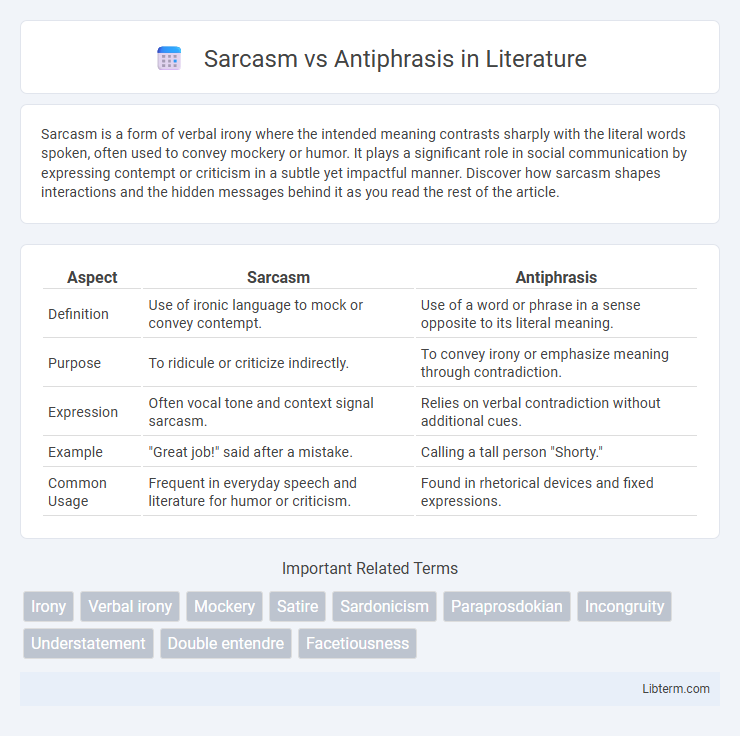Sarcasm is a form of verbal irony where the intended meaning contrasts sharply with the literal words spoken, often used to convey mockery or humor. It plays a significant role in social communication by expressing contempt or criticism in a subtle yet impactful manner. Discover how sarcasm shapes interactions and the hidden messages behind it as you read the rest of the article.
Table of Comparison
| Aspect | Sarcasm | Antiphrasis |
|---|---|---|
| Definition | Use of ironic language to mock or convey contempt. | Use of a word or phrase in a sense opposite to its literal meaning. |
| Purpose | To ridicule or criticize indirectly. | To convey irony or emphasize meaning through contradiction. |
| Expression | Often vocal tone and context signal sarcasm. | Relies on verbal contradiction without additional cues. |
| Example | "Great job!" said after a mistake. | Calling a tall person "Shorty." |
| Common Usage | Frequent in everyday speech and literature for humor or criticism. | Found in rhetorical devices and fixed expressions. |
Understanding Sarcasm: Definition and Features
Sarcasm is a form of verbal irony where contradictions between literal statements and intended meanings create humor or criticism, often marked by tone and context. Features of sarcasm include exaggerated expressions, sharp wit, and a purpose to mock or convey contempt indirectly. Antiphrasis, a subtype of sarcasm, involves using words with opposite meanings to emphasize the speaker's true intent in a more pointed and concise manner.
What is Antiphrasis? Key Characteristics
Antiphrasis is a rhetorical device in which a word or phrase is used in a sense opposite to its literal meaning, often to create irony or emphasis. Key characteristics include intentional contradiction, reliance on context for interpretation, and frequent use in sarcasm or humorous speech. Unlike straightforward sarcasm, antiphrasis specifically employs a single word or short expression as a form of verbal irony.
Historical Origins of Sarcasm and Antiphrasis
Sarcasm finds its origins in ancient Greek literature, where the term derives from the word "sarkasmos," meaning "to tear flesh," reflecting its biting and often harsh tone. Antiphrasis, a form of irony using words in a sense opposite to their literal meaning, traces back to classical rhetoric and was notably employed by Roman authors such as Cicero. Both devices evolved as sophisticated tools in rhetoric and literature, distinguishing themselves through their intent and linguistic application in historical texts.
Core Differences Between Sarcasm and Antiphrasis
Sarcasm employs irony to mock or convey contempt, often using exaggerated or opposite expressions to highlight criticism humorously or sharply. Antiphrasis specifically uses a word or phrase in a sense opposite to its usual meaning, commonly as a form of verbal irony where a single term carries the ironic weight. The core difference lies in sarcasm's broader scope involving tone and context to ridicule, while antiphrasis is a precise linguistic device relying on the intentional inversion of meaning for ironic effect.
How Sarcasm is Used in Everyday Language
Sarcasm in everyday language often involves saying the opposite of what one means to emphasize a point or express humor, frequently marked by tone and context. It serves as a tool for social bonding, criticism, or expressing frustration subtly without direct confrontation. Unlike antiphrasis, where a word is used ironically in isolation, sarcasm relies heavily on vocal cues and shared understanding between speaker and listener.
Antiphrasis in Literary and Rhetorical Contexts
Antiphrasis, a rhetorical device where a word or phrase is used in a sense opposite to its usual meaning, serves as a powerful tool in literature to convey irony and emphasize contrast. In literary contexts, authors deploy antiphrasis to create vivid characterizations or highlight contradictions, enhancing thematic depth and engaging readers through subtle humor or critique. Rhetorically, antiphrasis sharpens persuasive impact by provoking thought and eliciting emotional responses, making it a valuable strategy in speeches and written discourse.
Recognizing Sarcasm vs Antiphrasis: Practical Examples
Recognizing sarcasm involves identifying statements where the literal meaning contrasts sharply with the intended meaning, often signaled by tone or context, such as saying "Great job!" after a mistake. Antiphrasis, a subtype of verbal irony, uses words in a way that is opposite to their usual meaning for ironic or humorous effect, like calling a tall person "Shorty." Practical examples emphasize tone, context, and the speaker's intent to distinguish between sarcasm's biting wit and antiphrasis's ironic label.
Psychological Impact: Interpreting Sarcasm and Antiphrasis
Sarcasm often triggers cognitive conflict by delivering a message opposite to its literal meaning, engaging the brain's prefrontal cortex to decode tone and intent, which can either foster social bonding or create misunderstandings. Antiphrasis, a form of verbal irony where words convey their opposite meaning with clear contextual cues, demands less cognitive effort but still relies heavily on the listener's ability to interpret pragmatic signals, influencing emotional responses subtly. Both linguistic forms impact psychological processing by activating different neural pathways involved in social cognition and emotional regulation, highlighting the complex interplay between language and mind in everyday communication.
Cultural Variations in Sarcasm and Antiphrasis Usage
Sarcasm and antiphrasis exhibit significant cultural variations, influencing humor and communication styles across societies. In Western cultures, sarcasm often serves as a witty, indirect form of criticism or humor, while in some Asian cultures, its usage is less direct and may be perceived as impolite or confrontational. Antiphrasis, the use of words in a sense opposite to their literal meaning, also varies culturally, with some languages embedding it deeply in everyday speech to convey irony or satire, making contextual understanding crucial for accurate interpretation.
When to Use Sarcasm or Antiphrasis: Best Practices
Use sarcasm in informal settings where the listener is familiar with the speaker's tone, as it relies on exaggerated verbal irony to convey humor or criticism. Employ antiphrasis sparingly in contexts requiring subtlety, substituting words with their opposites for ironic effect without overt mockery. Both devices work best when the audience understands the cultural and contextual cues to avoid misinterpretation or offense.
Sarcasm Infographic

 libterm.com
libterm.com